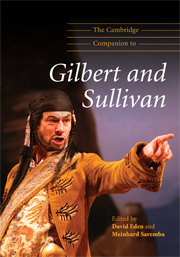Book contents
- Frontmatter
- Part I Background
- 1 Savoy opera and its discontents: the theatrical background to a quarrel
- 2 Identity crisis and the search for English opera: the Savoy Theatre in the 1890s
- 3 Resituating Gilbert and Sullivan: the musical and aesthetic context
- 4 ‘We sing as one individual’? Popular misconceptions of ‘Gilbert and Sullivan’
- Part II Focus
- Part III Reception
- Part IV Into the twenty-first century
- Appendix 1 Who wrote the overtures?
- Appendix 2 Stage and choral works by Arthur Sullivan and W. S. Gilbert
- Appendix 3 Modern editions of works by Arthur Sullivan and W. S. Gilbert
- Appendix 4 Sullivan's archetypes of English opera
- Notes
- Bibliography and further reading
- Index
- Plate section
1 - Savoy opera and its discontents: the theatrical background to a quarrel
from Part I - Background
Published online by Cambridge University Press: 28 September 2011
- Frontmatter
- Part I Background
- 1 Savoy opera and its discontents: the theatrical background to a quarrel
- 2 Identity crisis and the search for English opera: the Savoy Theatre in the 1890s
- 3 Resituating Gilbert and Sullivan: the musical and aesthetic context
- 4 ‘We sing as one individual’? Popular misconceptions of ‘Gilbert and Sullivan’
- Part II Focus
- Part III Reception
- Part IV Into the twenty-first century
- Appendix 1 Who wrote the overtures?
- Appendix 2 Stage and choral works by Arthur Sullivan and W. S. Gilbert
- Appendix 3 Modern editions of works by Arthur Sullivan and W. S. Gilbert
- Appendix 4 Sullivan's archetypes of English opera
- Notes
- Bibliography and further reading
- Index
- Plate section
Summary
The West End theatre as we know it is a Victorian in heritance. Many theatre buildings still stand from this period, but more importantly the methods of production and patterns of audience behaviour which we take for granted were established then. Those who work in the contemporary theatre often take exception to this state of affairs. They look on theatre-land as hideously bourgeois and seek, albeit in vain, to reclaim it for the working class. The Victorians experienced the same problem in reverse. For them the challenge was to overcome the disrepute of working-class association and establish the theatre as a domain of the respectable bourgeoisie. The Savoy operas have their full share of this ambition; but they are end products rather than prime movers. Their roots lie deep in the eighteenth century, or earlier, and we regard them as ‘entirely original’ only because we have ceased to be aware of those roots. Above all it should be understood that their ancestry does not lie in ‘opera’ as the term is generally used, but in the popular London alternatives to it.
Theatre regulation
Following the Puritan interregnum, which banned all forms of public entertainment, King Charles II in 1662 granted letters patent to Thomas Killigrew and William Davenant for the performance of ‘tragedies, comedies, plays, operas, music, scenes and all other entertainments of the stage’. One patent became established at the Theatre Royal, Drury Lane, while the other eventually devolved upon the Theatre Royal, Covent Garden. In 1766 George III granted a summer patent to Samuel Foote at the Little Theatre in the Haymarket, which duly became the third Theatre Royal. Theatres operating outside the patents were technically illegal, and ran under constant threat of interference by the authorities.
- Type
- Chapter
- Information
- The Cambridge Companion to Gilbert and Sullivan , pp. 1 - 21Publisher: Cambridge University PressPrint publication year: 2009



